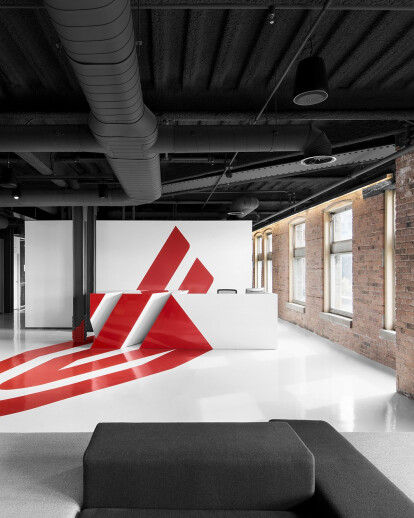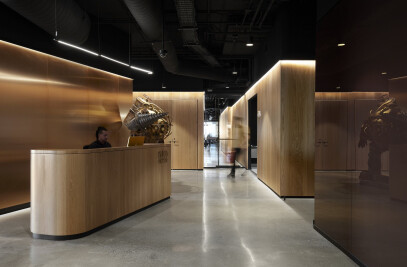For the new global headquarters of Lightspeed, a burgeoning, Montreal-based developer of point-of-sale software, ACDF Architecture reinvigorated three floors of the historical Viger train station and hotel, a nearly forgotten, chateaustyle building whose pointed turrets overlook a prominent civic square. The studio did so by preserving the found, raw elements of the once-abandoned space, superimposing a layer of select, slick, wit-filled elements that pop against the roughness and reflect the clients’ dynamic, creative and vigorous brand. Lightspeed has had a fast, audacious rise since it was founded in 2005, growing from a home-based business to a thriving global entity with satellites in Europe and North America. It aims to be the first Montreal tech company with a billion dollar valuation. At its headquarters, which are currently 30,000-square-feet with plans for another 20,000 by spring 2016, the company wanted room for an expanding workforce while retaining its culture as a tight-knit, nimble startup. Throughout, ACDF forged connections between the past and the future, reflecting the unique heritage and joie de vivre of its locale (setting it a part from the standard tech offices in Silicon Valley). Contemporary interventions such as slick glass walls, colourful pavilions, vibrant furniture and graphic art — with murals by Sao Paulo’s Arlin Cristiano and Montreal’s Jason Botkin — juxtapose industrial, found elements that speak to the building’s long history.
When the Viger Train Station and Hotel first opened in 1898, it was a local landmark with grandly detailed terra cotta walls. The onset of the Great Depression and the shift of Montreal’s downtown to the west caused a downturn in the 1930s. After a long period of disrepair, including 15 years of utter abandonment, ACDF began the office conversion, leaving a palimpsest of the station’s past. The studio revealed soaring double height spaces, with their immense timber beams, that were obscured during a 1950s remodeling; retained the rough-hewn brick walls that remained after the structure was stripped of its asbestos in the early 2000s; and left unadorned the ends of monumental, studded steel girders as they slide in and out of the work spaces. Now, a revitalized sense of levity is evident as soon as visitors step into the lobby. When seen from the elevator, the laminate reception desk looks like the flattened graphic of Lightspeed’s red-and-white logo — a fluid L and S that coil into the shape of a bright flame. From different perspectives, the anamorphic nature of the design is revealed. An assertive assemblage of sharply edged volumes jumps out, all the more because of the surrounding, coarse textures.
A similar sense of humour pervades the rest of the space. For example, ACDF installed three laminate cabana-shaped meeting pavilions in the lobby. Each looks like a mini, high-gloss house, a nod to the comforts of home as well as Lightspeed’s previous, much-smaller office, which was in a residential neighbourhood. An extra layer of wit heightens the sense of play: the studio painted permanent “shadows” on the adjacent floor and walls outside the pavilions. The cabanas are adjacent to the “pool,” a kitchen-side common area that references the backyard swimming pool at the previous office. The aqua-coloured area has a teal epoxy floor and fiberglass stools with a waterlogged pattern, custommade by millworker Etienne Hotte, both of which make the area feel as dream-like as the swim-up bar at your favourite resort. (Meanwhile Arlin Cristiano’s The Phoenix, a large, graffiti-style wall mural, adds an edge.) In the open-plan workspaces, stark white systems furniture streaks past the preserved ruins of industrial-age relics, soaring timber ceilings, garret-like nooks and elegantly frayed brick walls. The new-old contrast, as well as the infusion of Jason Botkin’s graphic, abstract lines and shapes, inspires a dramatic synergy that sparks the imagination and helps the youthful employees (the average age is 32) create. Future additions will push the themes further. A new, 960-square-foot patio off the “pool” area will have hot tubs and BBQs; an indoor, cigar-style lounge with herringbone floors and tufted leather couches; and a cloud-inspired, diaphanous amphitheater will ensure the 215 and counting employees feel entirely at home in the space.

































